If businesses were being honest, most of them would have to admit they have no idea what their brand is.
They fail what Seth Godin calls the brand formula, which I think is a clever model for thinking about what makes a company unique, and how powerful their relationship with consumers is:
[Prediction of what to expect] times [emotional power of that expectation]
It’s tough to grasp what that means without seeing an example, so here’s one Seth used that helped me understand it a lot better:
“AT&T is a weak brand because you almost never get what you expect, because they do so many different things and because the value of what they create has little emotional resonance (it sure used to though, when they did one thing, they did it perfectly and they were the only ones who could connect you).”
When you plug that into the formula, you get:
[I never know what to expect] x [when I get it, it’s not really a big deal]
Looking at it that way, it’s easy to see why AT&T has never given you the warm fuzzies you feel after interacting with companies that have great brands, like Apple or pre-E. coli Chipotle.
Still, while that example makes it easy to see why the brand value of massive companies can decline over time, it doesn’t explain why so many young, small companies fail to create memorable brands.
Why Most Companies Fail to Create a Strong Brand
Usually some combination of these three factors adds up to a weak or nonexistent brand:
- The company doesn’t understand their brand is the product of user expectations and user experience (the brand formula)
- The company thinks good branding = a cool logo
- The company lets their marketing dictate their brand
To quickly illustrate these factors in action, I’ll use an example I have more personal experience with than any other: Leadpages.
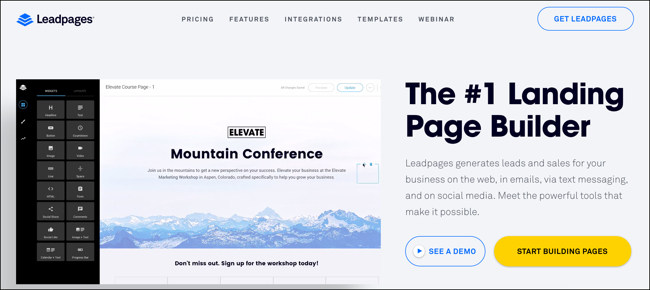
As you can see, Leadpages is software you can use to build landing pages. I’ve been a customer since 2013, worked as an employee on their marketing and product teams for 15 months in 2014-2015, and have worked on several projects with them since returning to freelance work.
So, full disclosure…I <3 Leadpages.
I had a front row seat to their rapid growth (0 – 40,000+ customers in 3 years, profitable since Day 1, raised over $30 million in venture capital) and I believe their brand was one of the driving forces behind it.
To show why, let’s put them in Godin’s brand formula.
[Prediction of what to expect]
Customers expect to be able to easily create a landing page that gets a great conversion rate. Since the product consistently delivers on this, customers quickly learn that they can rely on Leadpages to meet their expectation.
[Emotional power of that expectation]
When delivered, this carries way more emotional power than you probably think.
Building a nice-looking landing page that successfully sends leads to your email service provider—all by yourself—makes you feel like you did something magical. On top of that, every opt-in is validation that people want your stuff.
That feeling blew me away the first time I created a landing page for Copygrad, and I saw customers experience that same feeling again and again when I worked for the company.
When you put those things together, you get:
[Easily create a landing page that gets a great conversion rate] x [When that happens, I feel like a superhero and get validation about my business/product/idea]
By itself, this brand equation is very powerful. However, I contend that without another very important ingredient, it wouldn’t have helped Leadpages half as much as it did—the company’s awareness of the things that make up their brand formula.
It was their awareness that enabled them to take full advantage of what made their brand great and gobble up a much larger market share than every competitor.
A Brief Detour on Design Assets like Logos, Color Palettes, Etc.:
Before I get into brand awareness, I want to take a quick detour and talk about how little graphic design has to do with a brand’s overall strength.
Notice that this analysis of Leadpages’ brand hasn’t mentioned anything about logos, colors, or what their website looked like.
That’s because those types of design assets usually have very little to do with a brand’s value, despite the fact that people so often use “great logo” and “great branding” interchangeably.
(NOTE: I’m not talking about design as a whole. “Design” is a fairly abused term that is actually about much more than just what meets the eye. For the purpose of this detour, I’m only talking about the visual assets that represent a company.)
Earlier in 2016, Leadpages did a complete redesign of pretty much everything: logo, website, the web app UI, etc.
Here’s a before and after of the logo:
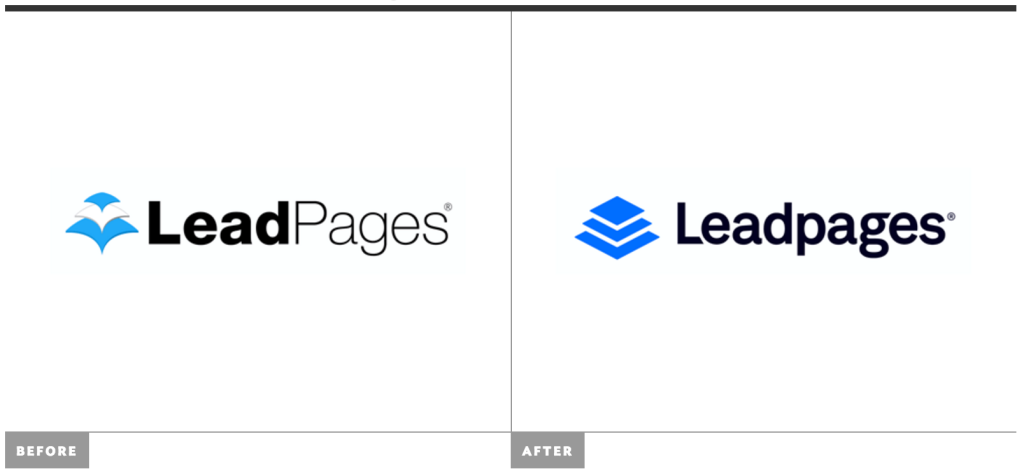
That graphic was featured in an analysis of the redesign on a blog called Brand New. They wrote:
“Overall, if I needed a service to create landing pages I would definitely consider using it based on its new look whereas I would have completely avoided it from the old.”
This is an interesting statement considering the fact that Leadpages had over 35,000 active paying customers before they updated their logo. If the author of the post truly did need a service to create landing pages (or took a moment to put himself in the shoes of Leadpages’ target customer), I don’t think he’d care all that much about the old logo and its use of Helvetica Bold.
Instead, his purchasing decision would be influenced much more by the emotional weight of the problems the product solves (which are touched on again and again in Leadpages’ marketing materials). Which brings me back to that brand awareness thing…
Brand Awareness: The Fuel of Winning Marketing Campaigns
Remember that third factor of why companies fail to create strong brands I mentioned earlier? “They let their marketing dictate their brand”?
Well, that’s what happens when a company lacks brand awareness. And I believe it’s the primary reason why so many companies stumble.
This mistake is easiest to understand when you can see an example of it.
Luckily, Basecamp’s David Heinemeier Hansson (usually known as DHH) surfaced a great one on Twitter recently—an email from the rental car company Sixt. Here it is, along with his commentary:

This is a somewhat extreme example, but I see businesses make the same mistake Sixt made here just about every day…
They let marketing dictate their brand, instead of letting their brand dictate how they market.
Let me explain.
If Sixt were to answer David’s question—“Are petty, insecure, and disgruntled losers really the core demographic you want?”—I’m sure they would say no.
They don’t want douchebags for customers. They just want more customers!
So to figure out how to get them, they turned to marketing, where they didn’t have to look far to find principles that justify this campaign, like:
“People don’t buy products; they buy better versions of themselves.”

“They laughed when I sat down at the piano, but when I started to play!”
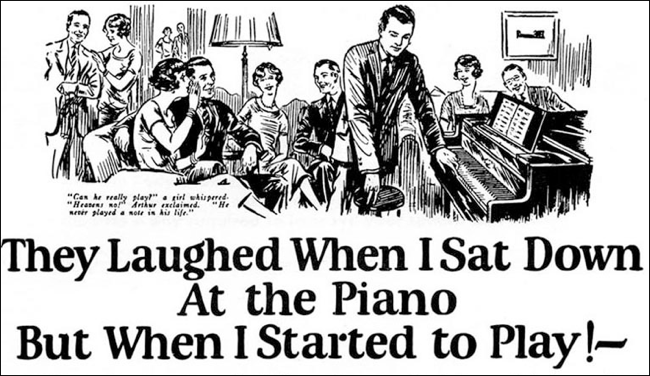
These all have their foundation in the tried and tested idea that people don’t want what you’re selling, they want what the product you’re selling allows them to become (or avoid).
People don’t want to book someone’s spare room; they want to escape and be spontaneous.
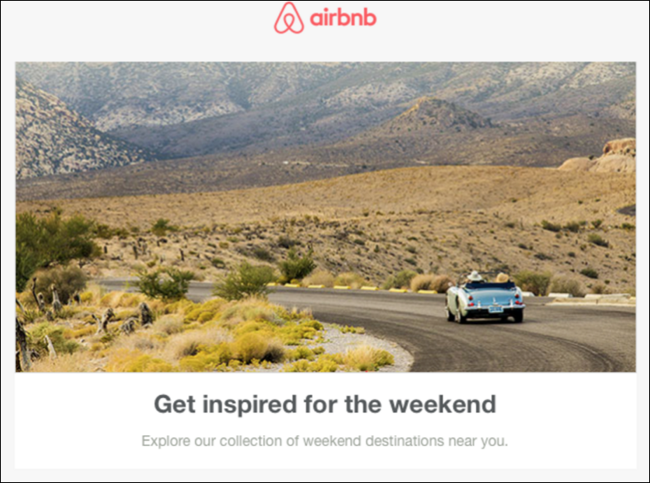
People don’t want a cooler; they want to be adventurous. (Note the references to adventurous trips and the imagery.)
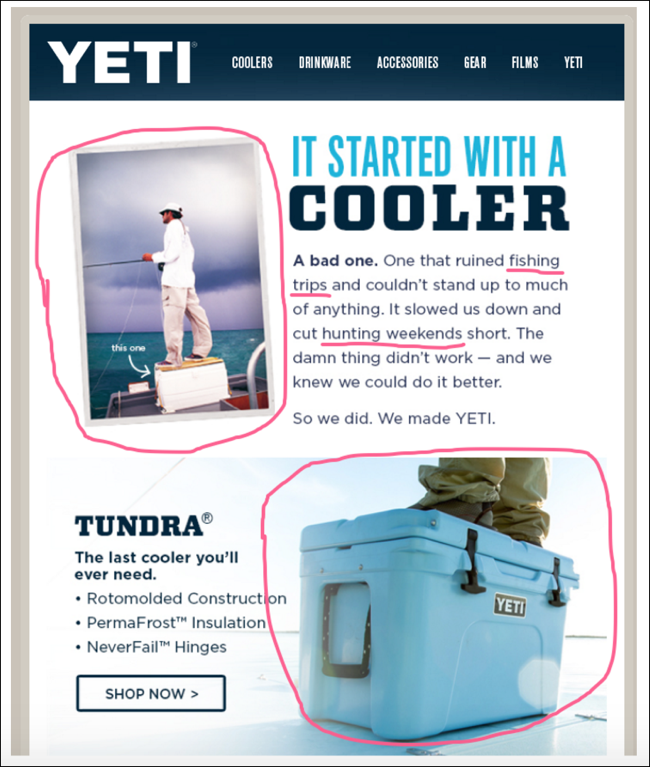
And in the case of Sixt’s email, people don’t want to rent a luxury car; they want to make their ex-girlfriends jealous.
So what went wrong? Why do the other two email examples using the same marketing principle seem to work, while Sixt’s is inspiring negative tweets?
Here’s why:
Sixt asked, “Is this a sound marketing principle?” rather than “How can we make this marketing principle work for our brand?”
Instead of letting their brand dictate their marketing, they let marketing dictate their brand.
What Drives This?
I’m guessing their primary motivation was to see a particular set of numbers increase. In this case, probably open rate, click rate, and car bookings.
(The final product also certainly says something about the awful way the advertising industry generally portrays women.)
Marketers are more driven by numbers right now than ever before, and it’s easy to see why. Data lets us discover some pretty cool stuff, after all. In many situations, it’s useful. But there are big problems with focusing on it too much.
I liked how Helpscout CEO Nick Francis put it in this blog post:
“The problem with data is that it has no way of knowing what makes your product or your business special. When you put all your trust in your metrics and the market, you lose the vision and perspective that led you to start your company in the first place… You lose touch with the things that matter.”
Making numbers go up on a sheet doesn’t guarantee your success. Worse yet, the things that do often go unseen.
When Coupled with a Focus on Brand, However…
…focusing on data can help amazing things happen.
This was one of the key lessons I took away from my time at Leadpages.
Everyone on the marketing team (thanks to the vision set by the company’s leadership) knew exactly what, as Nick put it above, “made the product special”:
It was really easy to build a great-looking landing page using templates that were proven to have high conversion rates.
Almost every piece of marketing content we produced showcased those two things. Nearly every week, some combination of folks like Jeff Wenberg, Stella Lungu, Kat Von Rohr, Jack Anderson, Sarah Chaussee, Kayla Sawtelle, and others created an in-depth video showcasing the latest landing page template to be released.
Clay Collins, our CEO, always reviewed each video and provided detailed feedback. This wasn’t micromanaging—when our marketing efforts showcased and aligned with the promise of Leadpages’ brand, the results were usually incredible. It was always worth taking the time to get it right. That attention to detail really ingrained into the culture the importance of making the things that made the product special always feel real and concrete.
When you have the level of brand awareness that went into making videos like that, and it’s built into everything you create and every interaction you have with potential customers, then it becomes much safer to let data inform (and sometimes make) your decisions.
So…What Should You Do to Build a Strong Brand?
My advice? Figure out your brand formula, and then make it an essential part of your company’s culture.
That doesn’t mean you should write it out and put it on some “Company Values” section of your website. You just need to have a high level of awareness of your customers’ expectations and your product’s emotional impact so you can make sure those things show up in everything your company does.
Take Warby Parker (the eyewear company that’ll ship you a box of frames to try on at home) for example.
In his book Originals, Adam Grant spent a chapter or so telling their origin story. While it would be stupid to point to any single factor as the reason why they’re now a billion-dollar company, one thing that did stand out was the way they thought about their brand. From the book (emphasis added):
“They tested different website designs with friends to see not only what would generate the most clicks, but also the strongest trust. Since other companies could sell glasses online, the founders realized that branding would be critical to their success. To name the company, they spent six months generating ideas and built a spreadsheet with more than 2,000 potential names. They tested their favorites in surveys and focus groups, finding that the Kerouac-inspired name of Warby Parker sounded sophisticated and unique, and evoked no negative associations. Then, they brought passion for execution in spades.”
To compete in a market that entrenched competitors had long dominated, Warby Parker knew their brand had to evoke feelings of trust, sophistication, and uniqueness. That awareness led them to not optimize exclusively for clicks, and to obsess over the company name to a degree that seems pretty silly.
I mean, spending six months coming up with a name before you’ve made a single dollar violates more best practices and conventional business wisdom than we have time to talk about. But it shows how critical the company’s founders realized those brand equation ingredients (trust, sophistication, uniqueness) would be when going up against mammoth competitors.
That obsession made those qualities not only a huge part of their branding and marketing, but also of the company culture. This quote from Ben Thompson’s article “The Curse of Culture,” though, shows why I think that’s mattered (and will continue to matter) so much to them in the long run:
“All companies start with the espoused beliefs and values of their founder(s), but until those beliefs and values are proven correct and successful they are open to debate and change. If, though, they lead to real sustained success, then those values and beliefs slip from the conscious to the unconscious, and it is this transformation that allows companies to maintain the ‘secret sauce’ that drove their initial success even as they scale. The founder no longer needs to espouse his or her beliefs and values to the 10,000th employee; every single person already in the company will do just that, in every decision they make big or small.”
Obsession over brand qualities was part of the “espoused beliefs and values of [the] founders” of Warby Parker.
That’s what has enabled them to build such a strong brand, and it’s why you don’t see them making aimless marketing decisions like Sixt did in that email DHH shared.
Seems Simple, Right? The Reality Is…It’s Hard to Get This Right.
The Sixt ad seems like something most of us would have been smart enough to reject had it come across our desks. But I used an obvious example because it clearly communicates the concept (and because it fell in my lap).
Most of the time, these decisions are subtler. Rather than potentially damaging your brand, they simply cause you to miss out on the opportunity to strengthen it.
It’s releasing a video that showcases your product’s features but ignores the emotional impact they have on customers.
It’s jumping on the latest “Growth Hack That Will Literally Explode Your Sales™” without considering if it highlights the ingredients of your brand equation.
It’s describing how you think your service helps people without taking the time to actually ask your customers how it helps them.
Figure out the things that make customers love your product/company/service and let them guide every marketing decision you make.
Let your brand dictate your marketing, and never the other way around.
